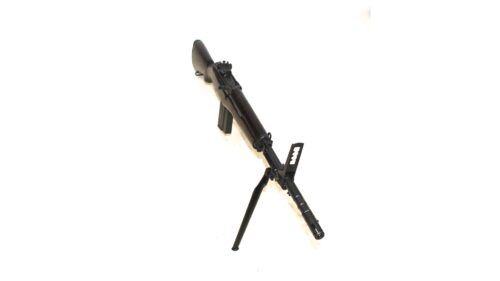Designed in 1941 by Louis Stange (MG 30 which developed into the MG15, MG17, MG34, MG42) Then produced in 1942. The FG42 is argued to be the rarest small arms of World War Two. The Fallschirmjägergewehr 42 or FG42 for short was a battle rifle, smaller than the standard German rifle yet weighing the same. The FG42 had the firepower of a light machine gun which could be fired from the shoulder. In addition to this it had the capability to fire rifle grenades and mount a bayonet.
It was chambered in the powerful 7.92x57mm with a 10 or 20 round detachable magazine.
The FG42 is famed for being the first single fire and fully automatic weapon of its time. Subsequently leading the way for many of the worlds modern firearms we see today.
History: In 1941 the Luftwaffe (German Air Force) after heavy causalities during Operation Mercury requested a universal shoulder-fired automatic rifle from their development branch in Tarnewitz. The Heereswaffenamt (Army Ordinance Department) quickly found the request unrealistic and declined the possibility of a weapon being produced with their aid. So, the Luftwaffe began without their help. Another setback came when Adolf Hitler considered the losses during Operation Mercury too great and questioned the effectiveness of the Luftwaffe and so plans were officially terminated. However, Hermann Göring privately gave permission for the project to continue. The Luftwaffe had a long list of prerequisites so development was crucial. Louis Stange re-developed the action used in the First War Lewis Gun. He refined a gas-operated turning bolt action and developed it to a standard of which the original design had never attained. It was far advanced for its time. The FG42 in single fire would shoot from a closed bolt yet in fully-automatic firing mode it would shoot from an open bolt to aid the cooling of the weapon.
This model is the first pattern. The differences between the two models are visually simple.
The stock on this pattern is pressed metal due to the availability of the material. However, on the second pattern it is wood, due to the fact that when the weapon overheated the stock (with being metal) would overheat also.
The bipod on the first pattern is located by the hand guard. This was moved to the muzzle area to acquire far greater grouping of rounds in full-automatic mode. Thus improving accuracy.
Finally, the pistol grip was moved from an angled position to near vertical as the angled position was great for firing whilst parachuting but affected the guns’ accuracy when on the ground.
The FG42 was produced in very limited numbers and is a very sought after piece by collectors today.
The FG42 was considered the most advanced and complex weapon for its time which is why it changed the way gas operated systems were designed.
Some high quality reproduction parts have been used to complete this weapon. These include Woodwork, Stock, Flash hider, Bayonet and one bipod leg.
Everything else is ORIGINAL including grips, trigger guard, body and complete with an ORIGINAL magazine.
More Photos Available on Request.
EU/UK SPEC.

















